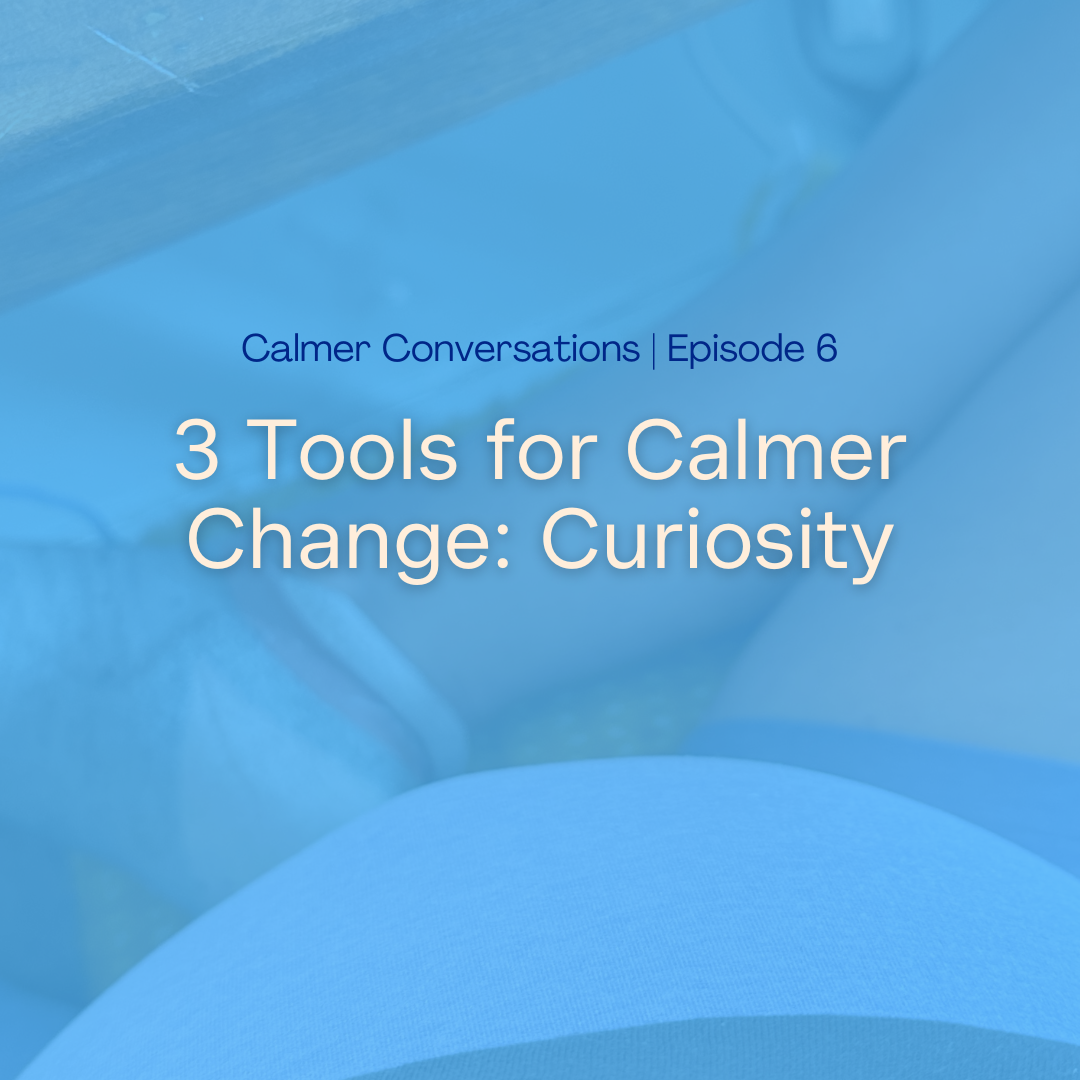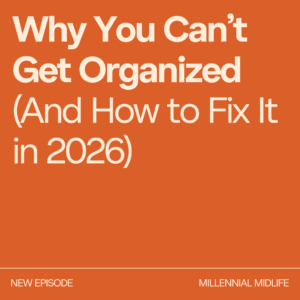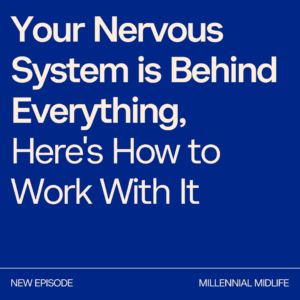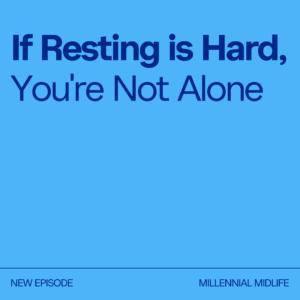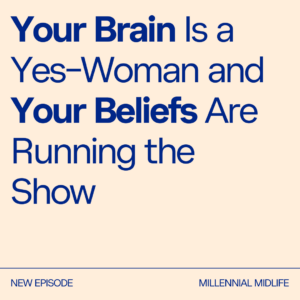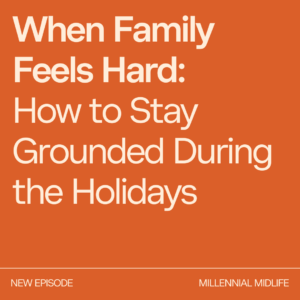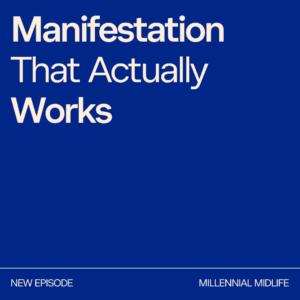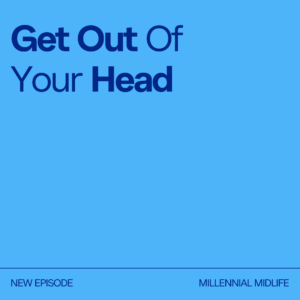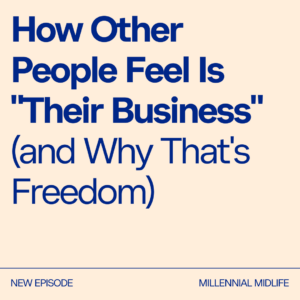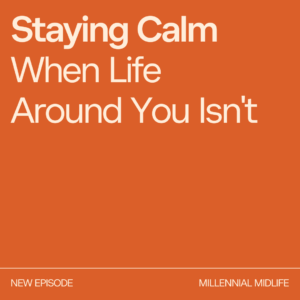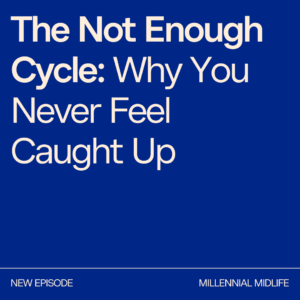Cecelia Baum Mandryk (00:01.431)
Hi and welcome to episode six of Calmer Conversations. I’m Cecilia, your host. Let’s get started. We are in the middle of a three week series that’s around working with your brain, specifically the three tools that I use daily and that I teach over and over again in different permutations to my clients that I use on Instagram that you’ve probably heard me talk about. Maybe not specifically using these words, but they are underlying all of the work that I do.
And those three tools are awareness, acceptance, and curiosity. Last week, we talked about acceptance. And the week before, we talked about awareness. And I’ll just do kind of quick overviews of those for you if you haven’t listened to those so you don’t feel like you’re totally out to see in this episode. And then I’m actually going to add on a little mini bonus week for next week that has come up over and over again in coaching recently. So, OK, the first tool and
Okay, so let’s just say these tools and the power of these tools are that they are very simple, that they get to the root of a lot of issues really quickly, that they bring you back into the present moment. And when we come back into the present moment, we recognize all the choice that we do have, we recognize what actually is true and happening in our life. And once we can do that, then we can start to work with
to either make changes or to start to be a certain way in your world. And I’m gonna put more words around that so it sounds less academic and more maybe applicable in your life. But these are at their heart mindfulness and mindset tools that work with your brain and your body. And as
say over and over again, I really think the power of working with your brain and your body is that you end up making change sort of in the flow rather than working against yourself. So a lot of times when people come to me, they have been able to make change in their life before, or they’ve gotten a lot of things done, but they’ve done it through willpower, they’ve done it through shame, they’ve done it through force, and it doesn’t really feel good. And they’re kind of wondering when in life are they going to get to enjoy themselves?
Cecelia Baum Mandryk (02:19.704)
When are they gonna get to have fun? When are they gonna get to do the things that they wanna do or spend more time doing the things that they wanna do? And these tools, I think are crucial for making that switch. And again, when you start to work with your brain to make change, suddenly you’re not relying on willpower, you’re not relying on force, you’re not shaming yourself, you’re not doing any of those things. Okay, so first let’s go into awareness. So awareness is the knowledge
perception of a fact, right? So awareness is when you can, let’s talk about non -judgmental awareness instead of just awareness, but non -judgmental awareness is a mindfulness practice and it involves becoming aware of a situation, of a fact, of something that’s happening, which your brain generally does relatively automatically, although as we’ve covered,
Your brain is not aware of as much as you think it is aware of because there are just so many pieces of information coming in at any one second. But non -judgmental awareness is being aware of something without judging a situation as right or wrong, without reacting with them, reacting to them. It’s being able to notice something and sit with your thoughts, right? So being starting to be…
to notice, to name a situation. I like breaking awareness up into noticing and naming actually. I think it’s one of the most powerful ways of doing it because you notice something and then you name it to yourself in a non -judgmental way. This is observing something and experiencing something without labeling them as good or bad, right or wrong, needing them to kind of fit into categories that you have predetermined in your head. Now your brain doesn’t want to do this. Your brain doesn’t want to be non -judgmentally aware
because your brain wants to conserve energy and keep you safe and seek pleasure. And being non -judgmentally aware means that you need to suspend judgment. You need to just notice something and name it for exactly what it is that you’re perceiving. And in doing that, you actually are keeping your brain from cutting corners, from conserving energy, and potentially maybe putting yourself in danger because you’re kind of going against your natural inclinations.
Cecelia Baum Mandryk (04:45.666)
So awareness is extremely powerful because a lot of times things are happening in our lives on autopilot. This came up in coaching in the group earlier today is that so often, somebody was saying that this work feels kind of hard and this work feels hard. And they started to say, because it feels like all of a sudden, they’re, I don’t know,
things are just harder in their life or they’re uncovering all these different layers and they’re more aware of things. But then they switched it around and said, but really I’m just more aware of how I was already feeling. I’m more aware of what I was already doing. And I think that’s super powerful because we are on autopilot. Our brain goes into autopilot very quickly, again, to conserve energy, to keep you safe, et cetera. So it’s not a problem that it does this, right?
But if you wanna feel differently in your life and you wanna start to make changes in your life, then bringing attention and intention to it, to what is happening, is the first step in making change. And it’s why not only did I talk about awareness for an entire episode, but I spent I think half of last episode talking about awareness. And it looks like I’m spending at least a good portion of this episode talking about awareness. So awareness is really this crucial first step.
and noticing, my brain does do that. I say that I wanna have fun. I say that I want more joy in my life, but really I spend a lot of time procrastinating. And when I think about what I want to do, the list is not wild. It’s not out there outrageous. It’s actually pretty normal things and I could give them to myself now, but why am I not, right? And so that actually touches very briefly on the curiosity that we’ll get into today, but noticing patterns is huge.
noticing them and naming them, but not making them right or wrong, not judging yourself for them, not shaming yourself, not going into embarrassment or hiding, but really trying to see them and see them for what they are, which is just the conditioning that you’ve had as a person. It’s just how you have been living. It’s just how you were taught to live by people in your life, by parents, by caregivers, by other humans of influence, by your society, religion, if you were part of a religion growing up, like anything like that. They all influence your brain.
Cecelia Baum Mandryk (07:04.172)
And so all the ways that you’re acting right now are just the result, the sum, the culmination of all those different people and things writing code in your brain, and then it’s playing out in your life. And until you bring awareness to it, and nonjudgmental awareness specifically, this conditioning is just running on the autopilot, right? And so with the awareness and with nonjudgmental awareness, what we’re doing is we’re starting to shine a light onto what’s happening. We’re just starting to see it for the first
So that’s awareness. The second step is going into acceptance. And acceptance, we talked last week that it’s not condoning, right? You’re not saying I want more of this, but it is saying this is what is happening in my current reality. In this space -time continuum thing that I am in, this is exactly what’s happening, or this person is behaving in this way. And when you can accept what’s happening, again, without making it right or wrong,
And you can even call it out as a very human way of acting or of being, or of, I don’t know, responding in the world. And maybe even saying, of course I’m responding this way. This is how I was conditioned to. Of course this is my response to this. This is how my mom used to always respond. This is how my grandmother always used to respond when this happened. I know where that comes from. Of course this is happening. This is just what my lines of code say. And so it’s okay that I’m here right now.
in the acceptance and why acceptance is so powerful is that oftentimes we think that in order to change something, we need to resist it. We need to push against it. We need to say, no, that’s wrong. I don’t like it. And there’s, there is some power in recognizing, I don’t like this pattern, but that’s after accepting it, the extra after accepting that this is the pattern that you are in. And the reason why the acceptance is so crucial first is because oftentimes if we don’t accept something or we’re too afraid to even look at it, right, that’s the awareness piece.
What we do is we put our nervous system into that sympathetic response. And the sympathetic response is that fight or flight. It’s the one where it’s really hard to make change. Your creative brain and your cognitive brain are not switched on when you’re in that space. And so if you want to make changes in your life and you want to feel differently, moving your nervous system into the place of the parasympathetic response or regulation, if you’d rather use that term, is really key.
Cecelia Baum Mandryk (09:30.316)
So if we’re trying to make change from resistance and force, we’re kind of, again, we’re going against the flow, right? We’re pushing against something. We’re trying to open a locked door versus if we’re in the space of regulation, if we’re working with awareness and with acceptance, we’re all of a sudden in flow. And that doesn’t mean that it’s gonna be totally easy peasy, hunky dory all the time, like rainbows and unicorns.
It could still be very well be difficult or uncomfortable, but it’s not as hard. And it feels a lot different because you’re moving with something instead of against something. And anytime you’re moving with something instead of against something, I mean, you can even just think about this in your own life. you’ve ever tried, mean, growing upstream is always like the example that people give, but you know, swimming against a current, right? It’s very hard going. I, I, when I lived in Denmark, I cycled.
as a way of, of transporting myself. And, I remember like it’s, Copenhagen’s a relatively windy city and very often it felt like either had a headwind or a like side wind, a crosswind. And every now and then I’d get like a pure tailwind and man, I was just on fire. I could cycle so quickly. Everything was just so much easier. And if you think you can back into your own life, you can probably see.
when this was the case, when you kind of were in flow, you were working with yourself and things just felt like they were easier, like they were going along in a different way than they are when you’re working against yourself, when you’re trying to force something. Okay, so that’s acceptance and awareness. So those are key. a phrase that I gave you last week that I think is really powerful that you can use with acceptance is how human of me
Like how very human of me to feel anxious in this situation. Of course I’m feeling this way. It’s okay that I’m feeling this way. I can feel anxious. I’m still safe in this moment. And those kind of verbal affirmations or those verbal responses that you can give to yourself are really powerful. And then I think I also mentioned this last week or I’ve mentioned it in the nervous system class that pairing that with a few slow breaths
Cecelia Baum Mandryk (11:51.95)
And kind of bonus points if you can breathe into your belly. You could even do box breathing if you know what that is or 4, 4, 6, 2, some, you know, a different ratio like that. But really, truly just slowly breathing into your belly, diaphragmatic breathing through your nose while you’re telling yourself you’re safe and you’re human is so extremely powerful for your nervous system and bringing you back to a place of regulation.
This also allows you to process the emotions that are happening and that are coming up. So you can even recognize like, I’m telling myself that I should be doing something different and I’m feeling shame. Right, I’m telling myself this should have been easier and I’m feeling this emotion with it. Or I’m worried that something is gonna happen and I’m feeling anxiety around it. So noticing not only if you can the story that’s happening or your behavior that’s happening, but also the emotion.
is this kind of critical middle step. And so often when we learn about this work and we learn about changing our thoughts, we just want to like skip from the quote unquote bad thought, the like thought we have been having to the thought that’s going to like save us. We don’t want to go through this middle step. But I will tell you, in my own life and watching clients over and over again, you have to go through the middle step. You have to process your emotions. And this is something in the club that we’ve been doing over the past couple of weeks is we have been
kind of diving into how do you feel emotions and how are you around other people when they’re having heart emotions, et cetera. So it’s, mean, these perhaps will become episodes of in their own right. But knowing that processing an emotion and learning how to sit with a heart emotion is actually really crucial. And I won’t go too much into it today, because again, it’s gonna be its own episode one day, but very often our experience of heart emotions is not the emotion itself, but it is our
resistance to that emotion. It is our fear of feeling it. It is our desire not to feel it that we actually experience that resistance, which again makes change hard, puts you into the sympathetic nervous system response, keeps you ultimately stuck. All right. So now that we’re probably more than halfway through the episode, let’s get to curiosity. So curiosity is the last step. Curiosity is the place where we get to start to open our brain
Cecelia Baum Mandryk (14:08.942)
play with different thoughts and ideas, where we start to ask our questions, what do I really want? And this is a really fun step because we’re bringing intentionality, we’re bringing desire into it, and we’re starting to ask. And like I said, I really like the idea of playing with different ideas instead of really militantly forcing yourself to adopt new ideas or knowing that there is a right way. But using the curiosity instead,
When you’re in this place and maybe you’ve said like, don’t actually like how I’m responding to this situation, or I don’t like sitting down and watching Netflix for two hours instead of going for a walk. I don’t like this. I want to do something different in my life. Great. So in that case, we’ve become aware of the habit, right? Behavior. We might even become aware of thoughts that we’re having, like this is going to be hard or it won’t matter, or it’s going to be boring or whatever else other thoughts you might have about going for that
And we might even have become aware of emotions, which may be resistance is one of the emotions or despondent if you feel like it’s not gonna work or avoidant in some way, right? So we’ve become aware of those and we might even say like, this is really human, right? I am not the only person on planet earth right now that is struggling to get off their couch and go exercise. And I know that that’s something I wanna do. Okay, so when we move into curiosity, then you start to ask,
What else do I already believe that could help me take the action that I want to take? So knowing that your thoughts are really crucial in changing what you do along with your feelings, we’re starting to get curious about what are the thoughts that I might have if I did go for a walk. If I was someone who went for a walk every afternoon, what would I think about myself? How would I describe myself? What kind of mindset would I be in when I get home from work?
or when I have a few moments later in the evening, whatever it is for you. And you can take this and you can kind of use it in your own examples or in your own life, but really starting to notice, okay, so how would I think? What would the story that I have about me? So for instance, somebody who does go for a walk every day, they may just have an identity of like, I’m a walker, or I get out and move my body every day. And if you’re somebody who
Cecelia Baum Mandryk (16:29.454)
coming home and sitting on the couch and watching Netflix instead of doing that, you probably don’t have that identity. So even noticing that you could switch into that is really powerful, right? So, somebody who does go for a walk would probably think like, I like going for walks. I always feel better when I go for walks. And you could start to ask yourself, do I believe any of those right now? And the way to test if you believe something is to see if it produces an emotional shift in your body. So,
The reason why, and this is another quick aside, but the reason why affirmations generally don’t work or sometimes don’t work for people, they can, you can kind of work with ones that you don’t believe and start to believe them over time. I entirely believe that’s possible, but sometimes it’s easier for us to start with things we already believe. So if you are somebody who doesn’t believe something, then you present the affirmation or the new thought in your head, like going for a walk could be fun or enjoyable.
and will experience no emotional shift in your body. You will still feel however you felt before. But if you do believe it, you will start to experience an opening, a shifting, a lightening. There will be some shift in your emotional body that you can start to sense. And even if you’re somebody who feels like you can’t sense your body, you’ll be able to tell the difference here. Or you’ll start to kind of notice like, it does maybe feel more possible, right? Maybe I do actually want to go for the walk. And that…
shift an emotional state is key because that means you already believe that thought. And so there is not one thought. There’s not one truth at any given time for any of us, right? Truth is changeable and stretchable and it’s there are many different truths that you believe at any one moment. So you might believe going for a walk is going to be hard, but you might also believe I’m going to feel better after I go for the walk, right? You can believe both things at the same time.
When we start to bring in curiosity and intentionality, what we do is we’re starting to ask, which one do I want to believe? You have a preferred neural pathway. That’s the one you have been thinking. That’s the habit you are in. And in this step, when we slow down, we’ve noticed that and we’re asking, do I want to keep going down that path? Do I want to keep honoring that neural pathway and that truth? Or do I want to start?
Cecelia Baum Mandryk (18:51.886)
kind of leaning into and trying out a different truth. Like, I feel better after I go for a walk or going for a walk could be fun. You can also ask if the thoughts don’t resonate with you. You can ask like, how do I want to feel? Right? And if I wanted to feel that way, what might I be thinking or what might I be doing to kind of get to that place? Right? And so maybe ultimately you think like, I want to feel healthy and at home in my body.
And like I can, like I’m not held back by my physical condition in some way. And so in that way, you might think like, okay, well, how could I start to get there? So curiosity is this place where you start to play with your brain and you start to think about what do I actually want in the future? Who do I want to be? How do I want to feel? Those are two of the most powerful questions you can start to ask yourself. Who do I want to be? Who am I growing into? And how do I want to feel? What are the emotions? What are
felt body senses that I’m going for, like maybe healthy or alive or invigorated or inspired, right? So thinking, how do I want to feel? And then starting to ask, okay, well, if that’s where I’m going, then how can I start to get myself there? And we’ll go into this in so much more detail. But right now I’m just starting to introduce the idea and curiosity at this stage too, when you’re just starting. And even in general is really just this opening.
Right? It’s if you’ve been looking down, you’ve been going down the same path over and over again, curiosity is pausing. The awareness is pausing and noticing what’s happening. Accepting is saying, okay, this is actually where we are right now and it’s okay. I’m safe right now. I’m human right now. And I could make changes, right? And so curiosity is then like looking up and saying like, what are my options? And if anything was my option, if I got to design how my afternoon went, what would I want it to look like?
If I gave myself permission to have fun, to enjoy myself, to do something different, what would it look like? And so in this place, we’re really just asking different questions. We’re opening our eyes. We’re looking in a different place. And I think again, this shift from being in the habitual autopilot mode to really pausing, slowing down, asking with nonjudgmental awareness, what’s happening, accepting it, and then really asking who do I want to be and how do I want to
Cecelia Baum Mandryk (21:13.622)
If I was thinking about my future self, what would I want to do right now? And I’ll maybe even come up with some more questions that we can put in the show notes, but more and more questions that kind of your brain likes to answer questions. It’s like a, it’s like a really great golden retriever, right? It really wants to fetch the thing and it will fetch what you ask it to fetch. So if you ask it to fetch the stick, it’s going to keep bringing back the stick. And that might be like, tell me how walking is awful and hard and I never do it. But if you want it to fetch the ball, will fetch the ball and the ball might
Why do I like about, what do I like about this? How is this a good thing? How does it benefit me? What do I believe when I’m thinking, when I’m doing this thing? Okay, so that’s curiosity for you. So acceptance, sorry, awareness, acceptance and curiosity. And these three steps, like I said, I come back to them over and over and over again in different permutations, in different ways that they show up for my clients, for myself. And so I will call them different things in many ways, but oftentimes,
The work that we’re doing is coming back to one of these or it’s starting at one of these. right. Bringing this into your own life, again, working without acceptance, working in the awareness, and then moving from the awareness to the acceptance, from the acceptance and the curiosity, and maybe pick one of these questions to start to introduce into some part of your day to see, could I think about this differently? Is there anything else that I believe at this time? Who do I want it to be today? How do I want to feel today?
And again, even just asking these questions, you’ll start to see changes in your life. Thank you so much for being here. If you try this out, come find me on Instagram, send me a message, let me know how it’s going, let me know what worked, what didn’t work, what was hard, what wasn’t. And I will be here next week.

